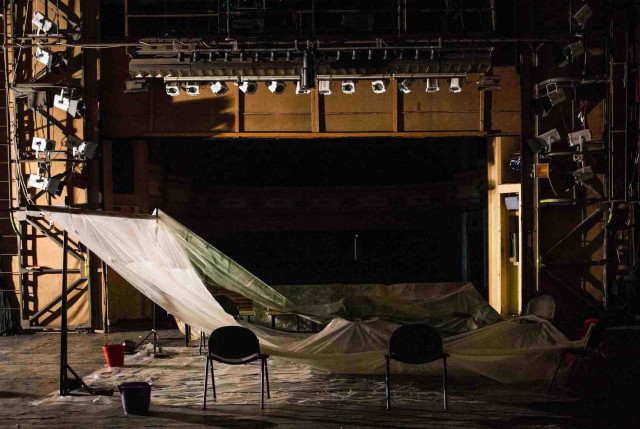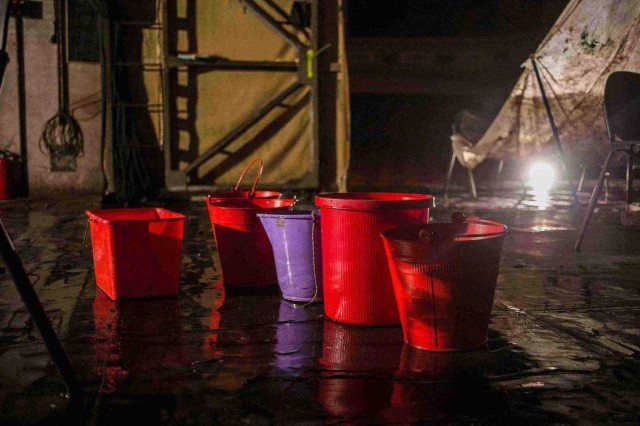(Continued from here)
Therefore the community was hit from two fronts – voluntary emigration and forced displacement.
All that remained was the theater – a bastion of low level architecture in a wasteland behind the tall new blocks, standing like a bright white canine in a mouth of knocked-out teeth.
Only 19 actors were still working at the theater.
“It was a period in which we performed in front of an audience of five,” says Rudi.
After the Romanian Revolution of 1989, the only difference was that there was no censor and the theater could stage what it wanted.
“But we were so censored within that we would censor ourselves,” says Rudi.
 Over six decades of Yiddish theater, the stage is now hosting a tarpaulin to catch leaking water from a busted roof
Over six decades of Yiddish theater, the stage is now hosting a tarpaulin to catch leaking water from a busted roof
I meet Maia Morgenstern, one of the most popular actors on the Romanian stage, in her office.
It’s doubling up as a dressing room, with nineteenth century dresses hanging from the side of the open doors of cupboards. She sits back and talks, while smoking gold-tipped Sobranie cigarettes.
When 80 square metres of the theater collapsed, the stage became waterlogged. Sets and clothing were wrecked.
The day after the storm, Morgenstern herself – at 51 years of age – risked her life by dangling aloft the remaining roof by gyropes to take pictures of the wreckage.
Now the stage – which for 63 years has showcased classics of international theater and contemporary work – is hosting a giant plastic tarpaulin that collects leaking water.
The actors still rehearse in the rooms, but the stage is not fit for performances and the seats lay empty. Any attempt to light the stage could result in a fire.
“It’s not because of the weather,” she says. “We always have wind and snow, but the fact that you can see the disaster is just the tip of the iceberg.”
Morgenstern, whose film roles include Mary, the mother of Jesus in Mel Gibson’s ‘The Passion of the Christ’, is fighting a battle to ensure the building is renovated.
The building needs a restoration. As a historical monument, the Romanian law states it has the right to be preserved.
But who will carry this out and when is a problem.
I try to contact the City Hall, but the officials at the Investment Directorate, which deals with the theater, refuse to meet me or talk over the phone.
The press department tells me they will answer my questions.
But after one month of waiting and soliciting for answers, they only send me a statement.
It details how they will reconstruct the interior and restore the electricity, heating and lighting in an 18-month contract at a cost of 3.1 million Euro.
They claim the Bucharest City Hall is now in a tender procedure for the award of the job.
But when I push them on when the works will begin and whether this takes into account the fact that the roof has collapsed, the officials fail to give me an answer.
“We have serious promises from the City Hall,” says Morgenstern. “We are assured this will happen. Nobody says to us ‘no this will not happen’.”
I ask her – what is the risk, if nothing materializes?
“I cannot think about this,” she says. “There is a danger concerning walls, the building, the structure – work has to be done. It is an emergency situation.”
 It is an emergency situation. There is a danger concerning walls, the building, the structure – work has to be done, says Maia Morgenstern, director of the theater
It is an emergency situation. There is a danger concerning walls, the building, the structure – work has to be done, says Maia Morgenstern, director of the theater
Rudi and the remaining players are running a homeless troupe, finding spaces in the studios and stages of Bucharest, where they perform in Romanian and Yiddish with translation.
Their existence depends on the charity of other theaters in the capital.
But can they still deliver quality material?
I catch the company performing Romanian-French playwright Gilles Segal’s ‘The Puppeteer’ in the upstairs studio of the Comedy Theater, directed by Alexander Hausvater.
Around 100 members of the audience are packing out the space.
It’s 1950s Berlin. A puppeteer named Finkelbaum has locked himself inside his basement room for seven years.
A survivor of the death camps, he is playing out his marriage, his relationships and the horror of Auschwitz with his box of puppets.
His landlady attempts to coax him out of his stupor, but he is reluctant to give in to her advances.
Rudi then enters the stage – playing a survivor of the camps and a friend of Finkelbaum.
If he cannot lure his friend back into the open, no one can.
The two friends strip to their shirts, share their memory of facing death as a daily routine, their shock and guilt of remaining alive – and how they must move on, how they must get out of the basement.
But Finkelbaum falls back into his delusion and the two remain in the room, both locked inside, with a chorus of puppets reliving memory in an eternal performance.
I spend my time checking out the audience. Are they getting this? I ask myself. Is this play really speaking to them in a language they can understand?
But there, at the front, are a group of teenagers, stunned, mesmerized with terror by the proximity to Finkelbaum as he delivers his delusions in a paranoid frenzy, pointing to members of the audience, accusing them of conspiracy.
Afterwards, the kids walk out of the theater, silent, confused, shocked, but thrilled – reeling from a punch to the brain.
Yiddish Revival
Yiddish culture has spent the last seven decades threatened by attacks from outside and within the Jewish community.
Israel banned Yiddish theaters in the 1950s, discouraging the use of the language in its efforts to bring Hebrew to the fore.
This is despite great texts in Yiddish, such as those of Isaac Bashevis Singer, the Polish-born Jewish American novelist who won the Nobel Prize in 1978.
But in the last few decades there have been attempts to reappraise the Germanic-based language.
In 2012, Rudi attended a UNESCO meeting in Paris about the revival of Yiddish.
“Each delegate pleading for the Yiddish language would say a few words in Yiddish and then started speaking in their own language with the help of a translator,” he says.
“No one spoke in Yiddish! Then I stood up and spoke in Yiddish and they had to translate for those to understand what I was saying! I lived a great sorrow, because I am one of the last Yiddish speakers as an actor.”
Another American director also asked Rudi to visit a theater college in the States as “one of the last Yiddish speaking people”.
“I feel terrible,” he says. “because I have the feeling I am a beetle in an insectarium.”
Yiddish is spoken by over 1.5 million people around the world, according to Ethnologue, yet precise numbers are unknown.
“It is sort of reborn,” says Morgenstern. “Yiddish is being reconsidered – its tradition, culture and language – all over the world.”
The actress learned Yiddish in the theater, which operates as a language class for a new generation of actors.
“We are discovering and I am discovering inside me new things, enjoying singing Yiddish, speaking and discovering new levels of spirituality.”
She even teaches Yiddish songs and texts at a local acting school in Bucharest.
“All kinds of audience are discovering that Yiddish theater and language is fun, fine, interesting, full of energy and full of meanings.”
Morgenstern wants the theater to remain as a platform for an open dialogue between Yiddish culture and the rest of the world.
Lingering anti-Semitism
In 1930 there were 728,000 Jews within Greater Romania, now only around 2,000 Jews remain in what remains of the country.
Almost 70 per cent of them are in Bucharest – with only a few hundred in the major cities of Cluj, Oradea, Iasi and Timisoara. The local office for the Right of Return is now closed.
However a sentiment of anti-Semitism is still present among many people. According to the National Center for Combating Discrimination in 2013, half of Romanians would not accept a Jew to be a relative and 35 per cent would not accept a Jew to live in Romania.
But a frightening statistic reveals that one in three Romanians would not even allow a Jew to visit Romania.
As I am in a taxi riding through Bucharest, the driver begins to talk to me about why Bucharest is such a mis-shapen city of huge wealth disparity and businesses that grow suddenly and then disappear.
He claims this is because so many firms in Romania – such as restaurants, shops, bars and casinos – are used as vehicles for money-laundering.
“And it’s the Jews,” he says, “the Jews who are guilty of using Romania to launder their money.”
I don’t say anything. I don’t even nod to humor him.
“How do you say the word ‘zgârcit’ in English?” he asks.
“It’s a specific word to Romanian, I guess you can best translate it as ‘stingy’.”
“Yes, like the Jews,” he said. “the zgârcit Jew.”
He laughs and rocks back and forth in his seat.
“Except you don’t need to say zgârcit jew, when you say Jew, we already know you mean zgârcit!”
I tell this to Rudi and he is not surprised.
“I did not have problems with anti-Semitism under Ceausescu,” he says. “Unfortunately, now, because life is hard, this comes out: the Jews are to blame. It’s pathetic, but that’s it. Nothing is changing. As long as a single Jew exists, there will be anti-Semitism; get that into your head!”
The actor blames a lack of education and information. Only in the last few years have Romanian schools began to teach about the holocaust.
Last year, according to the Romanian National Center for Discrimination, 30 per cent of Romanians didn’t know what the Holocaust was.
From the remaining 70 per cent, almost half do not believe it happened in Romania.
In 2011, Rudi performed a staged version of the Diary of Anne Frank in schools in Romanian.
“After the show, the teachers would remain and talk about the Holocaust.
“The students had no idea about the Holocaust, how many died and how they died.
“I told them a few things about the Holocaust and told them to ask questions.
“I said I was in a concentration camp in Transnistria and that I only knew the taste of sugar when I was four years old, and I spat it out because it was a new thing for me.
“Then one kid put his hand up and asked me: ‘Do you hate Germans?’. I told him no, I don’t hate Germans.
“He then asked me to give him an example of one German who I didn’t hate.
“I thought for a moment.
“Then I said to him: ‘Michael Schumacher. I mean – how can you hate such a talented guy?’”
***
With thanks to Natalie Ester, Erwin Simsensohn, Edith Negulici and Oana Monica Nae for helping with this article. Interior photos of the Theatre courtesy of TES
Preluat din publicaţia “The Black Sea” (v. aici) cu permisiunea autorului.
